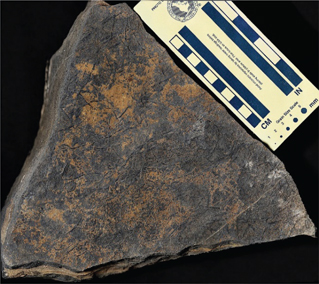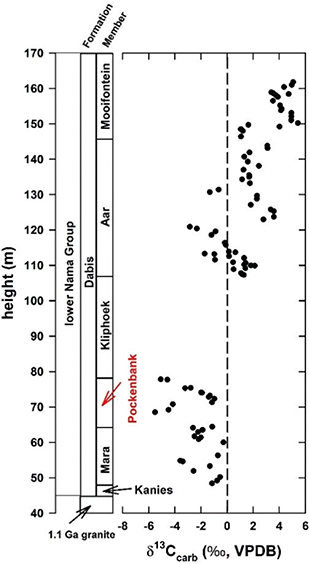When life got hard: An environmental driver for metazoan biomineralization
Cuando la vida anduvo errática: Un factor ambiental para la biomineralización de metazoos
A.J. Kaufman1, L. Kriesfeld2, P. Vickers-Rich2, G. Narbonne3
1Department of Geology and Earth System Science Interdisciplinary Center, University of Maryland, College Park, MD 20742, USA. Email: kaufman@umd.edu; ORCID ID: https://orcid.org/0000-0003-4129-6445
2Department of Earth, Atmosphere, and Environment, Monash University, Melbourne, Victoria 3800 Australia. ORCID ID: https://orcid.org/0000-0002-0192-6492, https://orcid.org/0000-0003-1850-8067
3Department of Geological Science and Engineering, Queens University, Kingston, Ontario K7L 3N6 Canada. ORCID ID: https://orcid.org/0000-0002-7897-8119
| |
ABSTRACT
The sudden appearance of biomineralized metazoans in limestone facies of the Pockenbank Member (Namibia) appears to reflect a rapid change of redox state, calcium concentration and alkalinity of the ocean. The coupling of a major biological innovation with the end of a profound carbon isotope excursion supports the view that the Shuram was a tectonic and oceanographic phenomenon, as opposed to a global diagenetic conspiracy. The temporal concordance of these profound events as preserved in strata from southern Namibia may thus be considered as exceptional geological markers for the base of the terminal Ediacaran.
Keywords: Biomineralization; Cloudina; Ediacaran; Namibia.
|
| |
RESUMEN
La repentina aparición de metazoos biomineralizados en las facies calcáreas del Miembro de Pockenbank (Namibia) parece reflejar un rápido cambio en el estado redox, la concentración de calcio y la alcalinidad del océano. La combinación de una importante innovación biológica con el final de una profunda excursión de isótopos de carbono respalda la idea de que la anomalía Shuram fue un fenómeno tectónico y oceanográfico, en contraposición a una “conspiración” diagenética mundial. La concordancia temporal de estos profundos acontecimientos, tal como se conservan en los estratos de Namibia meridional puede considerarse, por tanto, como marcadores geológicos excepcionales para la base del Ediacárico terminal.
Palabras clave: Biomineralización; Cloudina; Ediacárico; Namibia.
|
IntroductionTOP
Given the template-directed mineralization of their funnel-in-funnel carbonate shells (Grant, 1990), the terminal Ediacaran fossil Cloudina may represent the earliest complex multicellular metazoan. It remains uncertain, however, what drove these early animals to first biomineralize. Hypotheses include: (i) protection from predation, (ii) structural support, and (iii) calcium regulation.
The tubular fossil has a global distribution, but is best known from terminal Ediacaran strata of the Nama Group in southern Namibia – with a first appearance in the Mara Member (Germs, 1972), although the fossil has not until recently been relocated at this level since its discovery over 50 years ago. We found the tubular fossil in a newly-recognized unconformity-bounded sequence immediately above the Mara Member (and below Kliphoek Member sandstones containing elements of the soft-bodied Ediacara biota, including Ernietta and Pteridinium) in three locations south of Aus. This limestone-dominated sequence is provisionally named the Pockenbank Member after the farm where the biomineralized fossil was re-discovered. Cloudina at this deep stratigraphic level occurs as individual cones floating in a micritic matrix, as long strings of stacked funnels on microbial bedding surfaces (Fig. 1), and as lithified micro-reefs in intimate association with microbial mats.
|
 Fig. 1.–Cloudina preserved as long serpentine strings of funnel-in-funnel shells in microbialites mounds of the Pockenbank Member on Arasab Farm in southern Namibia south of Aus. This preservational window – suggesting that the organism grew recumbently along the mat surface and thus did not require structural support for orientation in currents – is remarkably similar to that of Cloudina in Ediacaran successions of Brazil (Becker-Kerber et al., 2017). In cross sections of the mounds, it is clear that both metazoans and microbes collaborated in the construction of reefs (contra Mehra & Maloof, 2018). Fig. 1.–Cloudina preserved as long serpentine strings of funnel-in-funnel shells in microbialites mounds of the Pockenbank Member on Arasab Farm in southern Namibia south of Aus. This preservational window – suggesting that the organism grew recumbently along the mat surface and thus did not require structural support for orientation in currents – is remarkably similar to that of Cloudina in Ediacaran successions of Brazil (Becker-Kerber et al., 2017). In cross sections of the mounds, it is clear that both metazoans and microbes collaborated in the construction of reefs (contra Mehra & Maloof, 2018).
|
|
ResultsTOP
The occurrence of Cloudina immediately above the dolomitic Mara Member is critical insofar as this unit preserves evidence for the greatest negative carbon isotope anomaly in Earth history – the Shuram Excursion – when Ediacaran oceans were broadly ventilated and oxic conditions likely prevailed in shallow marine environments near the end of the environmental perturbation. Given the global distribution of the Shuram Excursion, its stratigraphically cohesive pattern of carbon, sulfur, and strontium isotope change, and its preservation in a wide range of depositional lithofacies (Grotzinger et al., 2010), the carbon isotope excursion may be understood in terms of the pulsed addition of 12C-rich alkalinity to the oceans (Kaufman et al., 2007; Cui et al., 2017). The duration of the carbon isotope event is poorly constrained, but the sudden appearance of thick carbonate platforms worldwide (especially notable in siliciclastic-dominated successions) at this time supports the view of a profound environmental shift broadly coincident with the rise of animals.
The driver of the Shuram Excursion and the onset of biomineralization is envisioned as tectonic in nature, and related to widespread Pan-African orogeny as East and West Gondwana were sutured (Squire et al., 2006). Erosion of uplifted Ediacaran terrains delivered thick piles of sediments to the oceans, as well as bio-limiting nutrients, especially N, P, and Fe, sulfate, and carbonate alkalinity (as well as Ca2+) released through silicate weathering. Alternatively, the 12C-rich alkalinity may have built up in anoxic seawater through microbial sulfate reduction promoted by the weathering flux of sulfate to the oceans and a vast reservoir of dissolved organic carbon – although it is the growth of the oceanic Ca2+ reservoir that most likely promoted animal biomineralization. Insofar as phosphate-based metabolism necessitates the exclusion of calcium from cells (most-likely in order to thwart the formation of highly insoluble of calcium phosphate), Ca2+ concentrations are highly regulated in animals. Cellular levels of the cation are <1000x of those in the extracellular fluid
(i.e. blood), and the excess Ca2+ is either excreted to the environment or stored in bones and shells. All cells have active transport mechanisms to remove Ca2+ and import phosphate and magnesium in order to regulate important biological functions, including metabolism, protein confirmation, and signaling. In particular, locomotion through muscular contraction requires constant oscillations in the concentration of Ca2+ within the cells, so storage of the element as inert minerals outside of animal cells provides a distinct advantage, and is hypothesized to have precipitated from a sudden increase in dissolved oceanic calcium abundance during the Shuram Excursion.
Elemental maps of Cloudina in polished sections of the Pockenbank Member support the view that the shells were composed of a mixture of apatite and low Mg-calcite. Our regional chemostratigraphic analysis documents the final recovery from the Shuram Excursion within the newly-described sequence (Fig. 2). The negative δ13C compositions of Pockenbank carbonates suggests that seawater was still dominated by the flux of 12C-rich alkalinity, but the overall trend suggests that shallow seawater was becoming increasingly oxidized in this interval.
|
 Fig. 2.–Carbon isotope stratigraphy of the lower Nama Group at Farm Arasab, including the Mara, Pockenbank, Aar, and Mooifontein members revealing a strong negative to positive δ 13C shift through the strata. The FAD of Cloudina occurs in the limestone-dominated Pockenbank Member, which preserves the end of the negative Shuram Excursion. Fig. 2.–Carbon isotope stratigraphy of the lower Nama Group at Farm Arasab, including the Mara, Pockenbank, Aar, and Mooifontein members revealing a strong negative to positive δ 13C shift through the strata. The FAD of Cloudina occurs in the limestone-dominated Pockenbank Member, which preserves the end of the negative Shuram Excursion.
|
|
ConclusionsTOP
The sudden appearance of biomineralized metazoans in limestone facies of the Pockenbank Member thus appears to reflect a rapid change of redox state, calcium concentration, and alkalinity of the ocean. In sum, the coupling of a major biological innovation with the end of a profound carbon isotope excursion supports the view that the Shuram was a tectonic and oceanographic phenomenon
– as opposed to a global diagenetic conspiracy. The temporal concordance of these profound events as preserved in strata from southern Namibia may thus be considered as exceptional geological markers for the base of the Terminal Ediacaran System (Xiao et al., 2016).
ReferencesTOP
| ○ |
Becker-Kerber, B.; Pacheco, M.L.A.F.; Rudnitzki, I.D.; Galante, D.; Rodrigues, F. & de Moraes Leme, J. (2017). Ecological interactions in Cloudina from the Ediacaran of Brazil: implications for the rise of animal biomineralization. Scientific Reports, 7: 5482. https://doi.org/10.1038/s41598-017-05753-8 |
| ○ |
Cui, H.; Kaufman, A.J.; Xiao, S. & Zhou, C. (2017). Methane-derived authigenic carbonates from the uppermost Doushantuo Formation in South China: Was the Ediacaran Shuram Excursion a globally synchronized early diagenetic event? Chemical Geology, 450:
59-80. https://doi.org/10.1016/j.chemgeo.2016.12.010 |
| ○ |
Germs, G.J.B. (1972). New shelly fossils from the Nama Group, South West Africa. American Journal of Science, 272: 752-761.
https://doi.org/10.2475/ajs.272.8.752 |
| ○ |
Grant, S.W.F. (1990). Shell structure and distribution of Cloudina, a potential index fossils for the terminal Proterozoic. American Journal of Science, 290-A: 261-294.
|
| ○ |
Grotzinger, J.P.; Fike, D.A. & Fisher, W.W. (2010). Enigmatic origin of the largest-known carbon isotope excursion in Earth’s history. Nature Geoscience, 4: 285-292. https://doi.org/10.1038/ngeo1138 |
| ○ |
Kaufman, A.J.; Corsetti, F.A. & Varni, M. (2007). The effect of rising atmospheric oxygen on carbon and sulfur isotope anomalies in the Neoproterozoic Johnnie Formation, Death Valley, USA. Chemical Geology, 237: 65-81. https://doi.org/10.1016/j.chemgeo.2006.06.023 |
| ○ |
Mehra, A. & Maloof, A.; 2018. Multiscale approach reveals that Cloudina aggregates are detritus and not in situ reef constructions. Proceedings of the National Academy of Sciences, USA, 115: 2519-2527.
https://doi.org/10.1073/pnas.1719911115 |
| ○ |
Squire, R.J.; Campbell, I.H.; Allen, C.M. & Wilson, C.J.L. (2006). Did the Transgondwanan Supermountain trigger the explosive radiation of animals on Earth? Earth and Planetary Science Letters, 250: 116-133. https://doi.org/10.1016/j.epsl.2006.07.032 |
| ○ |
Xiao, S.; Narbonne, G.M.; Zhou, C.; Laflamme, M.; Grazhdankin, D.V.; Moczydlowska-Vidal, M. & Cui, H. (2016). Towards an Ediacaran Time Scale: Problems, Protocols, and Prospects. Episodes, 39: 540-555. https://doi.org/10.18814/epiiugs/2016/v39i4/103886 |
Fig. 1.–Cloudina preserved as long serpentine strings of funnel-in-funnel shells in microbialites mounds of the Pockenbank Member on Arasab Farm in southern Namibia south of Aus. This preservational window – suggesting that the organism grew recumbently along the mat surface and thus did not require structural support for orientation in currents – is remarkably similar to that of Cloudina in Ediacaran successions of Brazil (Becker-Kerber et al., 2017). In cross sections of the mounds, it is clear that both metazoans and microbes collaborated in the construction of reefs (contra Mehra & Maloof, 2018).